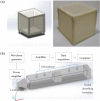A low-frequency multiple-band sound insulator without blocking ventilation along a pipe
- PMID: 36347855
- PMCID: PMC9643527
- DOI: 10.1038/s41598-022-21673-8
A low-frequency multiple-band sound insulator without blocking ventilation along a pipe
Abstract
It is challenging to insulate sound transmission in low frequency-bands without blocking the air flow in a pipe. In this work, a small and light membrane-based cubic sound insulator is created to block acoustic waves in multiple low frequency-bands from 200 to 800 Hz in pipes. Due to distinct vibration modes of the membrane-type faces of the insulator and co-action of acoustic waves transmitting along different paths, large sound attenuation is achieved in multiple frequency-bands, and the maximum transmission loss reaches 25 dB. Furthermore, because the sound insulator with a deep subwavelength size is smaller than the cross-sectional area of the pipe, it does not block ventilation along the pipe.
© 2022. The Author(s).
Conflict of interest statement
The authors declare no competing interests.
Figures




Similar articles
-
Engineering three-dimensional labyrinthine fractal acoustic metamaterials with low-frequency multi-band sound suppression.J Acoust Soc Am. 2021 Jan;149(1):308. doi: 10.1121/10.0003059. J Acoust Soc Am. 2021. PMID: 33514175
-
Measurement of Pipe and Fluid Properties With a Matrix Array-Based Ultrasonic Clamp-On Flow Meter.IEEE Trans Ultrason Ferroelectr Freq Control. 2022 Jan;69(1):309-322. doi: 10.1109/TUFFC.2021.3111710. Epub 2021 Dec 31. IEEE Trans Ultrason Ferroelectr Freq Control. 2022. PMID: 34506280
-
Determination of acoustic speed for improving leak detection and location in gas pipelines.Rev Sci Instrum. 2014 Feb;85(2):024901. doi: 10.1063/1.4863323. Rev Sci Instrum. 2014. PMID: 24593385
-
Low frequency attenuation of acoustic waves in a perforated pipe.J Acoust Soc Am. 2023 Mar;153(3):1791. doi: 10.1121/10.0017644. J Acoust Soc Am. 2023. PMID: 37002076
-
Underwater tunable organ-pipe sound source.J Acoust Soc Am. 2007 Aug;122(2):777-85. doi: 10.1121/1.2751268. J Acoust Soc Am. 2007. PMID: 17672628
References
-
- Tadeu A, Antonio JMP. Acoustic insulation of single panel walls provided by analytical expressions versus the mass law. J. Sound Vib. 2002;257:457–475. doi: 10.1006/jsvi.2002.5048. - DOI
-
- Fuchs HV. Applied Acoustics: Concepts, Absorbers, and Silencers for Acoustical Comfort and Noise Control: Alternative Solutions—Innovative Tools—Practical Examples. Springer; 2013.
-
- Kuo SM, Morgan DR. Active noise control: A tutorial review. Proc. IEEE. 1999;87:943–973. doi: 10.1109/5.763310. - DOI
-
- Lu MH, Feng L, Chen YF. Phononic crystals and acoustic metamaterials. Mater. Today. 2009;12:34–42. doi: 10.1016/S1369-7021(09)70315-3. - DOI
Grants and funding
LinkOut - more resources
Full Text Sources
Miscellaneous

